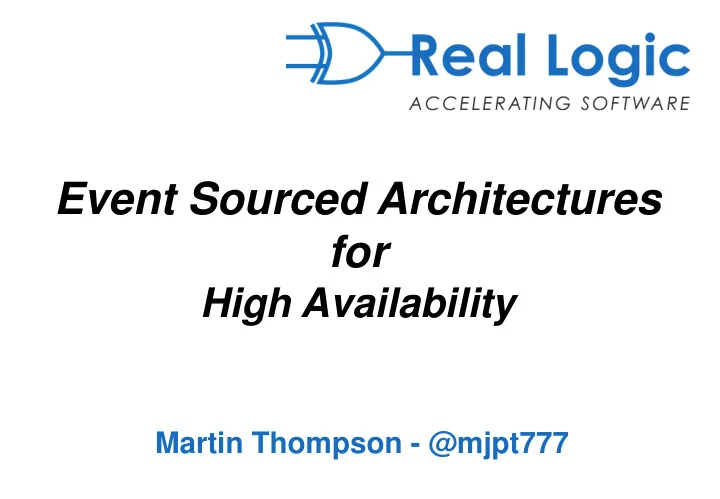

Event Sourced Architectures for High Availability Martin Thompson - @mjpt777
What Is “High Availability” ? • Availability refers to ability of the user community to access a system – not about Uptime! • By “High” availability we generally mean the system is always there when we need it • The 9’s are the typical way this is measured > 99.999%? When did the issue occur? • MTBF – Mean Time Between Failures • MTTR – Mean Time To Recover !!! • Bathtub curve for Failure Rates • System pauses (e.g. Garbage Collection) • What about hot upgrade?
The “Truth” About Production Outages • Admin “Cock -ups ” • Clustering Software • Hardware Failures • Software Bugs
High Availability: The Good, The Bad, The Ugly! • The Good : Queries > Go parallel with lots of replicas • The Bad : Updates > Some problems cannot be made parallel but some can > Lock step clusters • The Ugly : Distributed Resilience > Latency > Eventual Consistency > Data Loss > CAP Theorem
Transaction Processing & High Availability 1. Migrate between known good states 2. Replicate the step Databases > Oracle: SCNs, RAC nodes, replication > MySQL Cluster: Shards, 2PC, deltas and snapshots > MySQL: Clustered file systems, replication • Tandem NonStop – hardware & software stack with a message passing kernel • IMS TM transaction queue (Apollo Program)
“Event Sourced Design” “Capture all changes to an application state as a sequence of events” – Fowler (2005) “Apply a sequence of change events to a model in order” – Thompson Modern References: > “ Object Prevalence ” – Klaus Wuestefeld (2001) > Node.js > Nginx, G-WAN However the ideas have been around a long time...
Persistence and Recovery • Transaction Log > Record input sequence of events > Replay to rebuild system state on recovery > Great for performance testing and debugging! • Snapshots > Used to speed up recovery > Do not need to keep transaction logs forever • Data Migration > Change model when system is to be upgraded > Fix data issues
Event Sourced Architecture External System Gateway << High Performance Messaging>> Domain Model Event << Sequenced >> Services Events << Live Working Set >> Archive Database Journal Replica
HA Clusters Event Service Event Service 1 2 Cluster << Guaranteed Delivery >> Control << Replication>> << Replication>> Primary Data Centre DR Data Centre << Gating >>
Replication Models & Failure Detection Complexity Elastic Cluster Delta Stream Multi-Active Delta Stream Active Cluster Delta Stream Passive Cluster Delta Stream Block Shipping Log Shipping Protection
Importance of Design & Testing • Unit & Acceptance Tests in CI • Defensive argument checking • Aggregate methods for “transactions” • Exception handling • Getting this stuff right is easier than concurrent programming in the business model! • These approaches are amazing for helping you learn > Replay production logs for analysis and bug fixing
Scaling Event Sourced Architectures • CQRS – Command Query Responsibility Segregation > Multiple read nodes/threads from same event stream • Shards > People, Stuff, and Deals > Can partition on nodes/threads • Complex Transactions > Same approach as CQRS if single shot > Most complex transactions are best broken down into a state model with steps Note: In-memory asynchronous designs give great performance!
Questions? Blog: http://mechanical-sympathy.blogspot.com/ Twitter: @mjpt777
Recommend
More recommend